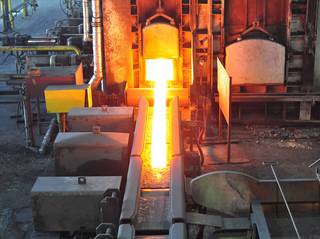Today we would like to look into a niche topic: What needs to be considered when lift tables are used at very low temperatures (e.g. in cold storage) or at high temperatures (e.g. in steelworks)?
Low temperatures
The following points also apply to scissor lift tables used outdoors, of course, because the lift tables should also function reliably in winter.
The hydraulic oil
If the lift table is used outdoors , selecting the correct hydraulic oil is usually sufficient. If the scissor lift table is used inside buildings, most lift table manufacturers use HLP32. A temperature range between -10 °C and 40 °C is usually recommended for this.
For outdoor applications, we use thinner hydraulic oil, usually oils according to ISO VG 22, which is recommended for temperatures from -20 °C.
Even if these temperatures fall below these limits, it is still possible to use a hydraulic lift table . In this case, the hydraulic oil can be heated to a sufficient temperature by a tank heater, for example.
Quite simple heating systems with a two-point controller are mostly used for this purpose, so that both the installation itself and the later operation is possible without major problems.
What else must be considered?
Even though the hydraulic oil certainly has the greatest influence at lower temperatures, there are a few more points that the design engineer should take into account.
Choosing the right steel grade
Not only the behaviour of hydraulic oils is influenced by the temperature, steel also has different properties depending on the operating temperature.
At low temperatures, notched impact strength plays a decisive role. The notched impact strength is a measure of the resistance to impact stress. As the temperature drops, so does the notched impact strength, so the choice of steel must be adapted to the respective operating temperature.
Not to be neglected: Lubrication
It is also important to take a look at the bearings and lubrication of the lift table. If the temperature is too low, for example, grease can become too viscous or solidify. A sufficient lubricating effect would no longer be guaranteed in this case. For this reason, care must also be taken to ensure that the grease has a suitable viscosity.
When it gets hot ...
Not only low temperatures can be a challenge to the structure of a scissor lift table , but so also high temperatures.
The hydraulic oil and the power unit
Let's start with the hydraulic oil. As mentioned before, hydraulic oils not only have a minimum operating temperature, but also a maximum oil temperature.
Furthermore, high temperatures can also cause problems with the actual hydraulic pump . Here the maximum recommended oil temperature is usually 80 °C. In order to ensure operational safety, sufficient cooling of the pressure medium must therefore be ensured.
Another point: choosing the right power unit. As already explained in the article “Compact power unit or under-oil unit?“, we are in fact big fans of under-oil units. For example, they have a more pleasant noise profile for the same output.
However, they have a decisive disadvantage at high ambient temperatures. The electric motor emits its waste heat directly to the hydraulic oil, creating an additional heat source for the pressure medium. For this reason, we use compact power units at high ambient temperatures.
What else must be considered?
Of course, sufficient cooling of the hydraulic oil is not enough. Depending on the operating temperature, the following points below must also be considered.
The bearings
Care must be taken to select the correct bearings, especially when the scissor lift table is used in the high temperature range. The maximum operating temperature for normal plastic plain bearings is 100 °C, for example. If these are replaced with special high-temperature bearings, however, operating temperatures of 160 °C can be handled.
Lubrication
Just as with temperatures that are too low, too high temperatures also present challenges for bearing lubrication. Again, the correct viscosity class of the grease used must be selected or greaseless bearings must be used.
The surface coating
Depending on the operating temperature, the surface coating of the scissor lift tables can also become a problem. A temperature above 180 °C is considered critical for normal paints, for example. However, it is problematic that the paint is no longer dimensionally stable at lower temperatures and therefore no longer provides sufficient protection under load.
As a scissor lift is made for lifting loads, it is obviously impossible to avoid a load, so that a different solution should be chosen early on.
In this case, hot-dip galvanising is a sensible alternative to classic painting. The maximum application temperature for bath galvanising is 315 °C, for example.
Another alternative could be to dispense with surface coating completely and use use stainless steel instead, for example .
The steel
With the choice of materials, we have also arrived at the last topic. Not only do you have to choose the right steel at low temperatures, but you also have to make sure that the right choice is made at high temperatures.
At very high temperatures, the steel loses a substantial part of its strength, so that the stability of the actual steel structure may no longer be guaranteed.




Comments (0)
No comments found!